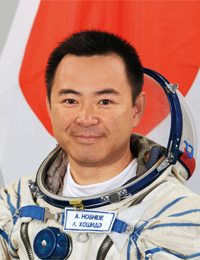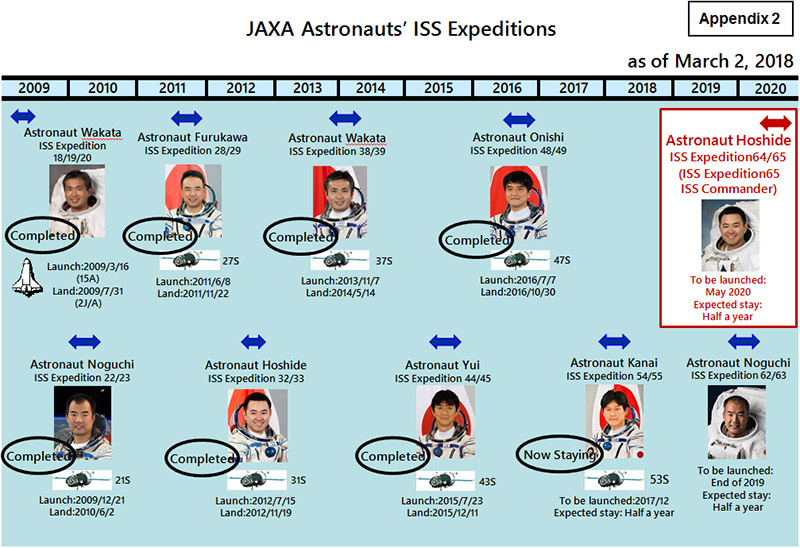JAXA Astronaut Akihiko Hoshide
Selected as ISS Expedition crew member and assuming the post of Commander
March 2, 2018 (JST)
National Research and Development Agency
Japan Aerospace Exploration Agency (JAXA)
The Japan Aerospace Exploration Agency (JAXA), a national research and development agency, is delighted to announce today that JAXA Astronaut Akihiko Hoshide was selected as a crew member of the International Space Station (ISS) Expedition 64/65. He will be the second Japanese to assume the post of commander on the ISS in leading the 65th Expedition.
Selected as a JAXA astronaut candidate in 1999, Astronaut Hoshide was launched as a mission specialist (MS) aboard the Space Shuttle in June 2008 for the second of three missions to deliver the Japanese Experiment Module (“Kibo”) to the ISS. In July 2012, he also flew aboard the Soyuz spacecraft (31st launch of crew members to the ISS: 31S), working onboard for 124 days as flight engineer for the ISS Expedition 32/33 mission. The ISS Expedition 64/65 will be the third spaceflight for Astronaut Hoshide.
- Period of stay in space: Approximately six months starting around May of 2020
- Mission:
Expedition 64 (approx. four months): Activities as the ISS Flight Engineer, mainly consisting of maintenance of the ISS facilities (including “Kibo”), scientific experiments, and manipulation of the Mobile Servicing System (MSS)
Expedition 65 (approx. two months): In addition to the above activities, taking the lead as ISS Commander for a successful mission and ensured safety of the crew - Project schedule: Training necessary for the long-duration stay on the ISS scheduled to begin around autumn 2019
Appendix:
Appendix 1
Brief Personal History of JAXA Astronaut Akihiko Hoshide

Akihiko Hoshide
Japan Aerospace Exploration Agency (JAXA)
Astronaut
49 years old (as of March 2, 2018)
| 1968 | Born in Tokyo. |
| 1992 | Received a bachelor's degree in Mechanical Engineering from Keio University |
| December 1997 | Received a Master of Science in Aerospace Engineering from the University of Houston, Cullen College of Engineering. |
| 1992-1994 | Joined the National Space Development Agency of Japan (NASDA, currently Japan Aerospace Exploration Agency) in 1992 and worked as a member of NASDA's Nagoya office. |
| 1994-1999 | Worked as an astronaut support engineer for the NASDA Astronaut Office, supporting the development of the astronaut training program and the evaluation of crew interfaces designs. He also supported astronaut Koichi Wakata during his training and mission on the STS-72 mission. |
| February 1999 | Selected as one of three Japanese astronaut candidates for the International Space Station (ISS), together with Dr. Satoshi Furukawa and Naoko Yamazaki. |
| April 1999 | Started NASDA's Basic Training program for astronaut |
| January 2001 | Certified as an astronaut |
| April 2001 | Participated in ISS Advanced Training, while working on development of the hardware and operation of the Japanese Experiment Module "Kibo" and the H-II Transfer Vehicle (HTV) |
| May 2001 | Certified as a Soyuz-TMA Flight Engineer. He was dispatched to NASA's Johnson Space Center (JSC) in June 2004. He went through NASA's Astronaut Candidate Training at JSC |
| February 2006 | Qualified for flight assignments aboard the space shuttle as a Mission Specialist(MS). |
| March 2007 | Selected as a crew member for the STS-124 (1J) mission, the second of three Kibo assembly-related missions, which delivered the Japanese Experiment Module (JEM) "Kibo" to the International Space Station (ISS). |
| June 2008 | Flew to the ISS on the STS-124 mission. He installed Kibo's Pressurized Module (PM) on the ISS using the Space Station Remote Manipulator System (SSRMS). He also operated the SSRMS for relocation of the Experiment Logistics Module-Pressurized Section (ELM-PS). During the mission, he performed Kibo-related activities, such as activations of the PM and Kibo's robotic arm, the JEM Remote Manipulator System (JEMRMS). |
| November 2009 | Assigned as a flight engineer for the ISS Expedition 32/33 mission. |
| July - November 2 2012 | Stayed on the ISS for 124 days as a flight engineer for the Expedition 32/33 mission. His mission included experiments in Kibo, ISS maintenance, three times of Extravehicular Activity (EVA), and deployment of CubeSats using the JEM Small Satellite Orbital Deployer (J-SSOD). He also supported few unmanned cargo ships which delivered various cargos to the ISS, including H-II Transfer Vehicle (HTV) "KOUNOTORI3" and Dragon cargo spacecraft (SpX-1). He flew on the Soyuz TMA-05M spacecraft (31S) for both launch and return. |
| July 2014 | Served as Commander of the 18th NASA Extreme Environment Mission Operations (NEEMO18), an undersea expedition at the National Oceanic & Atmospheric Administration's "Aquarius" habitat in Florida, USA. |
| April-October 2016 | Assigned as the Head of JAXA Astronaut Group |
Appendix 2

Appendix 3
JAXA President’s Comment on the Assignment of
JAXA Astronaut Akihiko Hoshide
as ISS Expedition Crew Member and Commander of Expedition 65
March 2, 2019
It is my great pleasure to announce today that, with the approval of the International Space Station (ISS) Multilateral Crew Operations Panel (MCOP), JAXA Astronaut Akihiko Hoshide has been assigned as a crew member of ISS Expedition 64/65 and as Commander of the 65th Expedition mission.
According to the current program, Astronaut Hoshide is scheduled to work during his approximate six-month stay on the ISS from around May of 2020, and will assume command of the whole ISS during the 65th Expedition mission.
In 2008, Astronaut Hoshide participated in the Space Shuttle flight mission to launch the Japanese Experiment Module (“Kibo”) by installing the Pressurized Module (PM) and the JEM Remote Manipulator System (JEMRMS) onboard the ISS, and activating the robotic arm.
During his 124-day stay for the ISS Expedition 32/33 mission in 2012, he also performed verification work to establish the deployment procedures for CubeSats using the JEM Small Satellite Orbital Deployer (J-SSOD), and engaged in extravehicular activity to replace equipment.
In addition to his activities in space, Astronaut Hoshide served as Commander of the 18th NASA Extreme Environment Mission Operations (NEEMO18) in 2014, leading a multinational astronaut team that included two NASA astronauts and an ESA astronaut.
The tasks successfully completed during his missions in space, coupled with the training he received and the results of work he performed on the ground have earned him high acclaim at JASA and the overseas agencies participating in the ISS program, which now bestows on him the honor of taking the lead as ISS Commander.
Tomorrow, on March 3, the Japanese government will hold the Second International Space Exploration Forum, where participants will exchange ideas on international cooperation in space exploration.
We will strive further to accumulate achievements in manned space activities by Japanese astronauts during their continuous long-duration stays on the ISS, and develop new technology and accumulate knowledge that will help Japan take initiatives in international cooperation programs, including space exploration.
We firmly believe that our activities contribute to obtaining results that will contribute to society, while enhancing the curiosity of the next generation of young leaders in the field of science.
Finally, for Astronaut Hoshide’s selection, we would also like to express our sincere gratitude here for all the efforts made by the people concerned both inside and outside JAXA.
Naoki Okumura
President
Japan Aerospace Exploration Agency
Appendix 4
Comment from Astronaut Akihiko Hoshide
March 2, 2018
It is a great honor to be assigned as a crew member of the 64th and 65th International Space Station (ISS) Expedition Missions, and to serve as the commander during the 65th Expedition Mission. The announcement comes coincidentally on the 10th anniversary of the first launch of the Japanese Experimental Module “Kibo”, a milestone to Japan’s human space flight. I would like to express my sincere gratitude to the people who worked to realize this assignment.
There has been a total of eight long duration missions thus far where Japanese astronauts, including Astronaut Norishige Kanai currently onboard, have performed duties as ISS crew members. Japan’s “Kibo” Module and H-II Transfer Vehicles (HTV) have been major assets to the ISS Program, contributing towards our everyday lives with the research and technology we gain. In recent years, many countries have started to participate in the space program. More companies in the private sector are starting to play major roles. New programs are being discussed to expand our horizons as human kind. This is an exciting new era, and I believe Japan has an obligation to fulfill a leading role in space exploration beyond ISS.
In 2020, athletes from around the world will meet in the Tokyo Olympic and Paralympic games. As the Commander for the 65th ISS Expedition Mission, I also look forward to overcoming the challenges, together with a team of extremely talented people, to expand our horizons for the benefit of present and future generations.
Akihiko Hoshide
Astronaut
Japan Aerospace Exploration Agency
Ø Brief Personal History of JAXA Astronaut Akihiko Hoshide